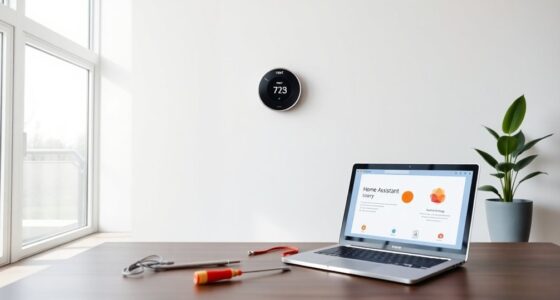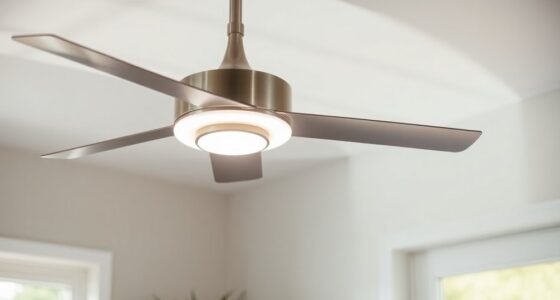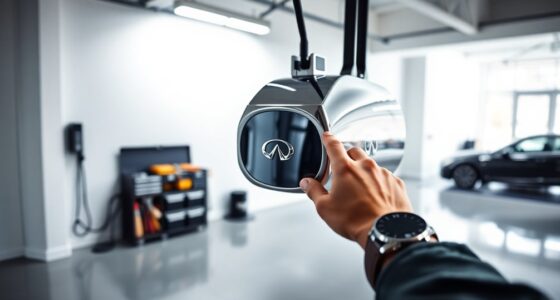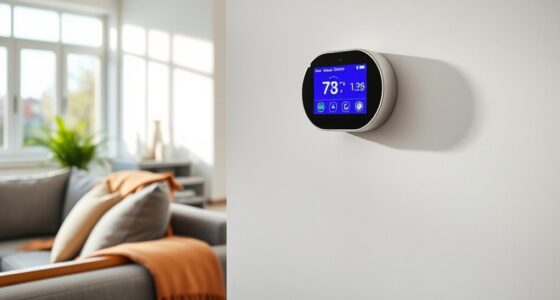If your Vicks humidifier water is black, it likely means your unit is contaminated with mold, bacteria, or mineral deposits. This can happen if you're using tap water or if the water sits stagnant for too long. To prevent this, change the water daily and clean the reservoir regularly—at least once a week—with a vinegar solution. Make sure to use distilled water to avoid mineral buildup. Unplug the humidifier and empty it each day to keep it clean. For more in-depth tips on maintaining a healthy humidifier, stick around for more insights.
Key Takeaways
- Black water indicates contamination from mold, mildew, or bacteria due to stagnant water and insufficient cleaning.
- Using unfiltered tap water can introduce additional contaminants that contribute to black water formation.
- Regularly cleaning and disinfecting the water reservoir prevents microbial growth and black water issues.
- Change the water daily and use distilled water to minimize mineral buildup and stagnant conditions.
- Avoid using liquid Vicks additives, as they can promote mold and bacteria growth in the humidifier.
Understanding Black Water in Humidifiers
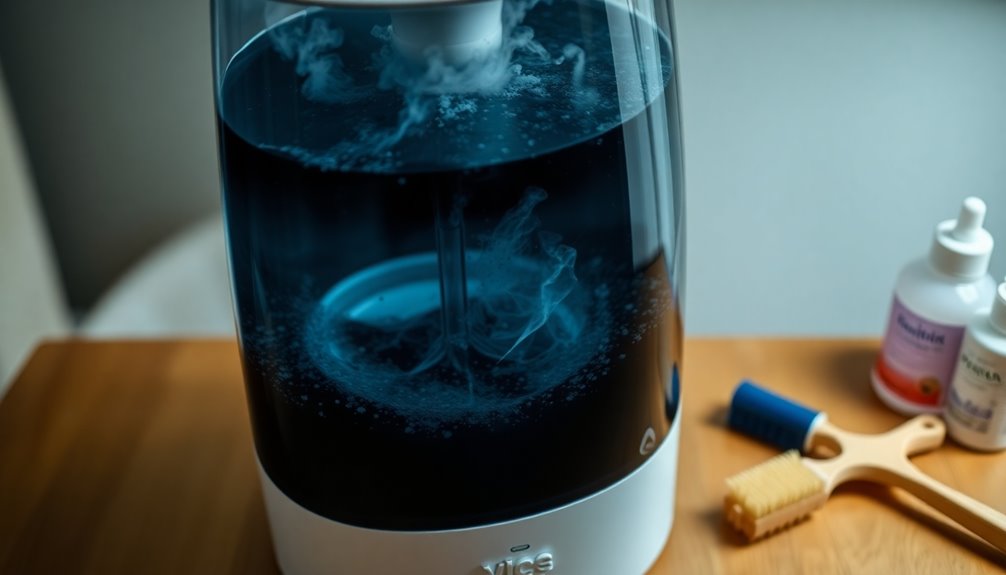
Black water in your humidifier is a clear sign of potential issues. It usually indicates contamination from mold, mildew, or bacteria due to stagnant water and insufficient cleaning.
When you use tap water with high mineral content, charred mineral residues can contribute to black water formation, compromising your humidifier's effectiveness.
To combat this, prioritize regular cleaning and disinfection of the water reservoir and components. Using distilled or demineralized water greatly reduces the risk of mineral buildup, helping maintain better water quality.
Monitor your water frequently and change it to prevent unpleasant odors and black water issues. By staying proactive, you'll guarantee a healthier humidifying environment for you and your family. Additionally, ensure that you follow manufacturer guidelines for maintenance to maximize your humidifier's performance.
Common Causes of Black Water

If you notice black water in your Vicks humidifier, it could be due to several factors.
Mold and bacteria thrive in stagnant water, while mineral buildup from tap water can create unwanted residue.
Additionally, using unfiltered water can introduce contaminants, making it essential to maintain good water quality.
Mold and Bacteria Growth
Mold and bacteria growth in a Vicks humidifier can lead to the alarming appearance of black water, which often stems from stagnant water and inadequate cleaning.
When you don't clean the humidifier regularly, warm, damp conditions create an environment where mold and bacteria thrive. This can release harmful spores into the water, posing respiratory risks, especially for sensitive individuals. Additionally, regular filter replacement is essential for maintaining a healthy air environment.
To combat this issue, consider the following maintenance tips:
- Change the water daily to prevent stagnation.
- Clean the humidifier thoroughly at least once a week.
- Use distilled water to reduce mineral buildup.
Mineral Buildup Issues
When using a Vicks humidifier, you might notice black water, which often results from mineral buildup. This buildup typically occurs when you use tap water, which contains high mineral levels. Over time, these minerals can accumulate and form black particles, especially when heated. To prevent this, consider using distilled water, which greatly reduces mineral buildup. Regular cleaning of your humidifier is also essential; soaking the steam unit in vinegar helps dissolve deposits. If you add salt to enhance steam production, be cautious—too much can worsen mineral buildup. Additionally, using HEPA filtration in your air purifier can help improve overall air quality by capturing airborne pollutants that may also affect your humidifier's performance.
| Cause | Effect | Solution |
|---|---|---|
| Tap water | High mineral content | Use distilled water |
| Mineral buildup | Black particles | Regular cleaning |
| Excessive salt | Increased buildup | Limit salt usage |
Water Quality Concerns
To ascertain your Vicks humidifier operates effectively, it's crucial to be aware of the water quality you use.
Black water often arises from the growth of mold, mildew, or bacteria due to poor maintenance and stagnant water. Mineral deposits from tap water can foster microbial growth, leading to contamination.
Here are some key tips to guarantee ideal water quality:
- Use distilled or demineralized water to prevent mineral buildup.
- Clean your humidifier regularly to eliminate any contaminants.
- Monitor for changes in water color, odor, or particles.
Health Risks Associated With Contaminants
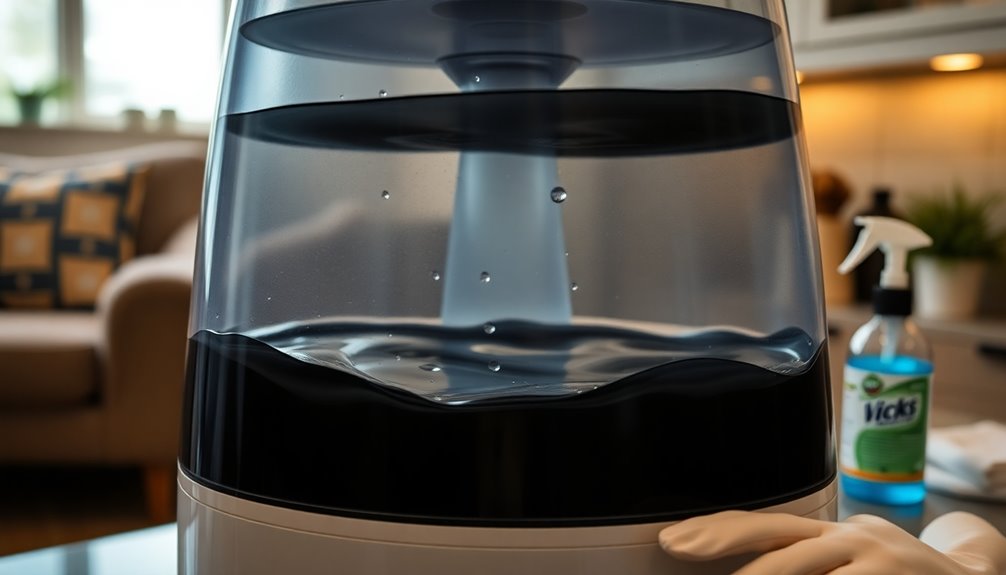
If you notice black water in your humidifier, it's a sign of potential contamination from mold, mildew, or bacteria.
Breathing in these harmful particles can lead to respiratory issues, especially for those with sensitivities. Regular cleaning and using distilled water can help keep your humidifier safe and reduce health risks. Additionally, maintaining a clean environment and being aware of common symptoms can help you identify potential health issues early on.
Mold and Mildew Risks
While maintaining a Vicks humidifier can improve your indoor air quality, neglecting it can lead to serious health risks associated with mold and mildew.
These contaminants thrive in humid environments, especially in poorly maintained humidifiers. If you don't clean your device regularly, stagnant water can become a breeding ground for mold and mildew, releasing spores that trigger allergies and respiratory issues.
To minimize these risks, consider:
- Using distilled or demineralized water to reduce mineral buildup.
- Regularly cleaning and disinfecting your humidifier to prevent contamination.
- Monitoring humidity levels to avoid excessive moisture in the air.
Proper maintenance is essential to guarantee your humidifier benefits your health rather than harming it.
Bacterial Contamination Effects
Bacterial contamination in humidifiers poses significant health risks, especially when you inhale contaminated mist. This can lead to respiratory issues as harmful microorganisms enter your lungs, increasing the risk of infections.
Furthermore, mold and mildew can thrive in stagnant water, releasing spores that trigger allergic reactions and worsen asthma symptoms in sensitive individuals.
Studies show that poorly maintained humidifiers can foster bacteria growth, creating biofilms that harbor pathogens. The Centers for Disease Control and Prevention (CDC) warns that these poorly kept devices can spread germs and viruses indoors.
To mitigate these health risks, you should prioritize regular cleaning and maintenance of your humidifier, ensuring a safe and healthy environment for you and your family. Additionally, consider using a best humidifier that features built-in maintenance alerts to help you stay on top of cleaning schedules.
Effective Cleaning Techniques

Cleaning your Vicks humidifier effectively is vital for maintaining its performance and guaranteeing a healthy environment.
Follow these cleaning instructions to prevent black residue and mineral buildup:
- Unplug the unit and empty the water tank daily, rinsing thoroughly to remove contaminants.
- For weekly maintenance, soak the steam unit in a vinegar-water solution (1 part vinegar to 3 parts water) for at least 10 minutes.
- Disinfect the reservoir with a bleach solution (1 teaspoon of bleach per gallon of water), letting it sit for 20 minutes before rinsing thoroughly.
Always use distilled water to minimize mineral deposits and help maintain ideal humidity levels.
Regularly monitoring and replacing the water every 24 hours is vital to prevent stagnant water and guarantee a clean humidifier.
Maintenance Best Practices
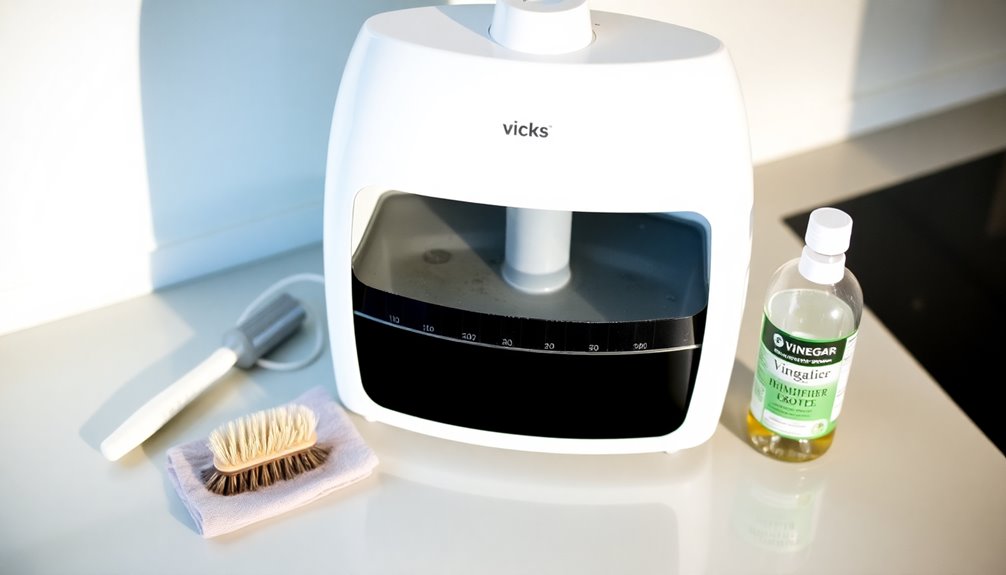
To keep your Vicks humidifier running smoothly and efficiently, it's essential to establish a consistent maintenance routine.
Clean your humidifier at least once a week to prevent mold, mildew, and mineral deposits that can lead to black water. Always change the water daily to minimize microbial growth and guarantee peak performance.
Using distilled or demineralized water helps reduce mineral content, keeping your unit cleaner. After each use, let the humidifier air dry completely to prevent moisture buildup, which can promote bacteria growth.
Follow the manufacturer's cleaning instructions and use a bleach solution for disinfection to keep the humidifier in good condition.
Water Quality Considerations

While you mightn't think much about the water quality in your Vicks humidifier, it plays an essential role in its performance and your overall health.
Using tap water can lead to black water due to minerals and impurities that promote contamination. To maintain a clean humidifying environment, consider these tips:
- Always use distilled or demineralized water to minimize mineral buildup.
- Change the water every 24 hours to prevent microbial growth.
- Regularly check for discoloration, unpleasant odors, or visible mold.
User Experiences and Solutions

Despite your best efforts with water quality, you might still encounter issues with your Vicks humidifier. Many users report seeing black particles, often linked to mineral buildup and mold due to insufficient humidifier maintenance. Here's a quick overview of user experiences and solutions:
| Issue | Suggested Solution | Tips |
|---|---|---|
| Black particles in water | Use distilled water | Lower mineral content |
| Mineral buildup | Regular cleaning | Soak steam unit in vinegar |
| Mold or bacteria growth | Switch to Vicks VapoRub | Avoid liquid Vicks additives |
| Charred residue | Consistent maintenance | Rinse thoroughly after cleaning |
Additionally, mineral buildup in humidifiers can often be mitigated by using distilled water, which has a lower mineral content compared to tap water.
Preventing Future Issues
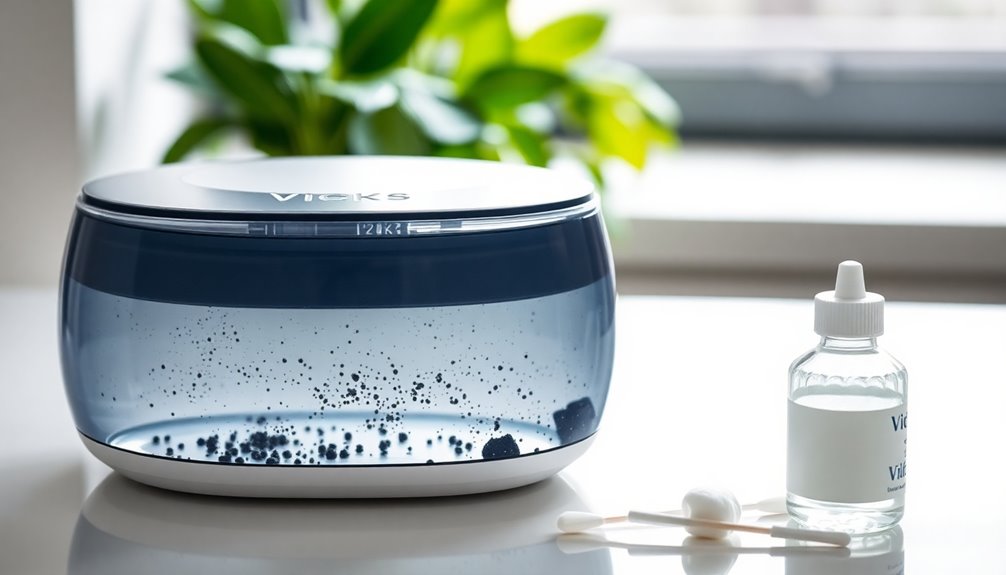
Preventing future issues with your Vicks humidifier relies on consistent maintenance and regular care.
To guarantee peak performance and prevent black water, follow these essential tips:
- Change the water every 24 hours to prevent stagnant water and reduce the risk of mold and mildew growth.
- Clean the humidifier weekly with a vinegar solution to eliminate mineral buildup and potential contaminants.
- Always use distilled or demineralized water to reduce mineral deposits that contribute to black residue.
Recommended Humidifier Models

When it comes to choosing a humidifier, you'll find a variety of models that cater to different needs and preferences.
If you're looking for a reliable option, consider the Everlasting Comfort Ultrasonic Cool Mist Humidifier with its 6-liter water tank, allowing for up to 50 hours of continuous operation.
The Levoit LV600S Smart Hybrid Ultrasonic Humidifier automatically adjusts humidity levels and features auto-shutoff for safety.
For cleaner moisture, the Honeywell HCM-350 Germ-Free Cool Mist Humidifier uses UV technology to eliminate 99.9% of bacteria.
If you prefer something quieter, the TaoTronics TT-AH001 is perfect for bedrooms.
Remember to use distilled water and prioritize cleaning ease to minimize the impact of minerals on your humidifier, including Vicks models. Regular maintenance and cleaning is essential to ensure optimal performance and longevity of your humidifier.
Frequently Asked Questions
Why Is My Humidifier Leaving Black Residue?
If your humidifier's leaving black residue, it could be due to mold, mildew, or bacteria thriving in damp conditions.
Poor maintenance often leads to this issue, especially if you're using tap water that contains minerals. These minerals can create scale, providing a breeding ground for unwanted growth.
Regular cleaning, weekly disinfection, and changing the water daily can help prevent this problem.
Consider using distilled water to minimize residue and keep your humidifier running smoothly.
Why Does My Humidifier Have Dirty Water?
Your humidifier may have dirty water due to stagnant water that allows mold, mildew, or bacteria to grow.
If you're using tap water, mineral buildup can also contribute to contamination.
To keep your humidifier clean, change the water daily and perform a deep cleaning weekly.
Using distilled or demineralized water can help prevent impurities that lead to dirty water, ensuring your humidifier works effectively and safely for your health.
Do Vicks Humidifiers Get Moldy?
Yes, Vicks humidifiers can get moldy if you don't maintain them properly.
Stagnant water and lack of cleaning create a perfect environment for mold to thrive. To prevent this, change the water daily and deep clean the tank weekly.
Using distilled or demineralized water can also help reduce mineral buildup and contamination.
Regular maintenance is key to keeping your humidifier clean and free of mold, ensuring peak performance and air quality.
Why Is There Black Mold in My Humidifier?
Like a scene from a horror movie, discovering black mold in your humidifier can be unsettling.
This mold often forms due to stagnant water that creates a perfect breeding ground for spores.
To combat this, you need to empty and dry your humidifier daily, and clean it regularly.
Using distilled water also helps minimize mineral buildup.
Don't forget to disinfect with a bleach solution to guarantee a safer, healthier environment in your home.
Conclusion
To summarize, discovering black water in your Vicks humidifier can be alarming, but don't panic just yet. By understanding the causes and implementing proper cleaning techniques, you can restore your humidifier to its former glory. But what if you neglect maintenance? The risks might surprise you. Stay vigilant, keep your water quality in check, and verify you're using the right model. After all, a little prevention now could save you from a bigger headache later. What will you do next?


